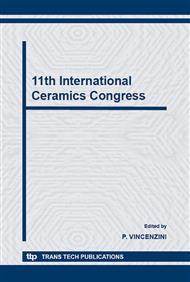p.2235
p.2240
p.2246
p.2254
p.2260
p.2266
p.2272
p.2278
p.2284
Particle Distribution Design in a Self-Flow Alumina Refractory Castable without Cement
Abstract:
A self-flow refractory castable (SFRC) without cement requires a matrix of fine particles and a broad size distribution of coarse particles (aggregate). The matrix ensures the rheological behaviour and performs the binding role of the absent refractory cement. The presence of the aggregate coarse particles hinders the flowability index (FI), but improves the castable mechanical strength and reduces firing shrinkage. A new methodology of SFRC particle distribution design was developed, using response surface statistical modelling and commercial alumina powders (reactive and tabular). First, the composition of the fine matrix was optimised, seeking minimum water content and maximum IF. To this matrix, various aggregate distributions, combining six tabular alumina size fractions and with different Andreasen distribution modulus, q, between 0.18 to 0.28, were added, to identify the composition with maximum FI. The results obtained show that a minimum specific surface area (SSA) of 2.22m2/g is necessary to reach the self-flow turning point, after which the largest FI requires the maximisation of the aggregate maximum paste thickness (MPT), corresponding to a distribution with q=0.22. The optimised castable composition presents high mechanical strength (>60MPa) and low shrinkage.
Info:
Periodical:
Pages:
2260-2265
Citation:
Online since:
October 2006
Authors:
Price:
Сopyright:
© 2006 Trans Tech Publications Ltd. All Rights Reserved
Share:
Citation:


